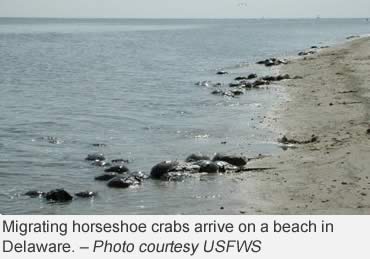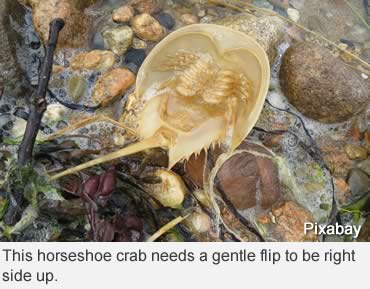During June, visitors to beaches in the mid-Atlantic states of Delaware, New Jersey and Maryland can see an astonishing sight – millions of horseshoe crabs making their annual pilgrimage from the Atlantic Ocean to the beaches where they will mate and nest.
It’s an event that has occurred for the past 350 million years, and remains one of the largest spawning events of horseshoe crabs in the world.
Most of the nesting activity takes place during high tides in the three days before and after a full or new moon. In 2017, the full moon takes place on June 9, and the new moon on June 23. During this spawning period, one horseshoe crab could lay nearly 20,000 eggs.
When mating, a male attaches himself to the top of a female’s shell, and together they crawl to the beach. Horseshoe crab larvae emerge from their nests several weeks after the eggs are laid.
Juvenile horseshoe crabs resemble adults except their tails are proportionally smaller. The young and adult horseshoe crabs spend most of their time on the sandy bottoms of intertidal flats or zones above the low tide mark and feed on various invertebrates.
 In Florida, horseshoe crabs nest year-round. Peak spawning is in the spring and fall when large nesting groups are found on beaches. However, the horseshoe crabs can be found from coastal Maine to Mexico.
In Florida, horseshoe crabs nest year-round. Peak spawning is in the spring and fall when large nesting groups are found on beaches. However, the horseshoe crabs can be found from coastal Maine to Mexico.
Although this ancient and valuable species looks menacing, horseshoe crabs are actually very gentle creatures and do not bite. However, their long, thin, spike-like tail has given them an unfavorable reputation.
Horseshoe crabs are more closely related to the arachnid family of spiders and scorpions than they are to crustaceans such as true crabs, lobsters and shrimp. They often have been called “living fossils” because their ancestors existed nearly 200 million years before dinosaurs. But, despite their longevity, their bodies have changed very little.
They are important to both coastal communities and human health.
Horseshoe crab eggs are a vital source of food for migrating shore birds, blue crabs, white perch and striped bass.
 Their importance to human beings cannot be underestimated. Their unique, copper-based blue blood contains the extremely valuable blood-clotting agent LAL, which clots in the presence of certain bacterial toxins unable to be detected by other means.
Their importance to human beings cannot be underestimated. Their unique, copper-based blue blood contains the extremely valuable blood-clotting agent LAL, which clots in the presence of certain bacterial toxins unable to be detected by other means.
The FDA requires the use of LAL to test all injectable and intravenous drugs produced in the U.S. The good news is that up to one-third of a horseshoe crab's blood can be removed without killing the animal.
Research on their compound eyes has led to a better understanding of human vision. Amazingly, horseshoe crabs have 10 eyes which are used to find mates and sense light.
To learn more about the horseshoe crab’s anatomy, click here.
“This ancient species isn’t the most nimble creature, and their short legs don’t do the best job of helping them right themselves,” said Maryland Department of Natural Resources biologist Steve Doctor, who conducts an annual survey of horseshoe crabs.
Beach visitors are often encouraged to help horseshoe crabs, too. Anyone who spots a horseshoe crab flipped on its pack should pick up the crab by its sides, not by its tail, and gently turn it over so it can continue on its way.
The Florida Fish and Wildlife Commission notes that although horseshoe crab numbers are declining throughout much of the species’ range, it is not threatened or endangered.
In 1998, The Atlantic States Marine Fisheries Commission developed a Horseshoe Crab Fishery Management Plan that requires all Atlantic coastal states to identify horseshoe crab nesting beaches. Currently, biologists at the Fish and Wildlife Research Institute are trying to document nesting sites of horseshoe crabs throughout Florida.
For more information, visit http://myfwc.com/research/saltwater/crustaceans/horseshoe-crabs/facts/
and http://dnr.sc.gov/swap/supplemental/marine/atlantichorseshoecrab2015.pdf.
Resources—The Maryland Department of Natural Resources, the Florida Fish and Wildlife Commission and the South Carolina Department of Natural Resources.
— Read recent Critter Tale:
You, too, can bioblitz!